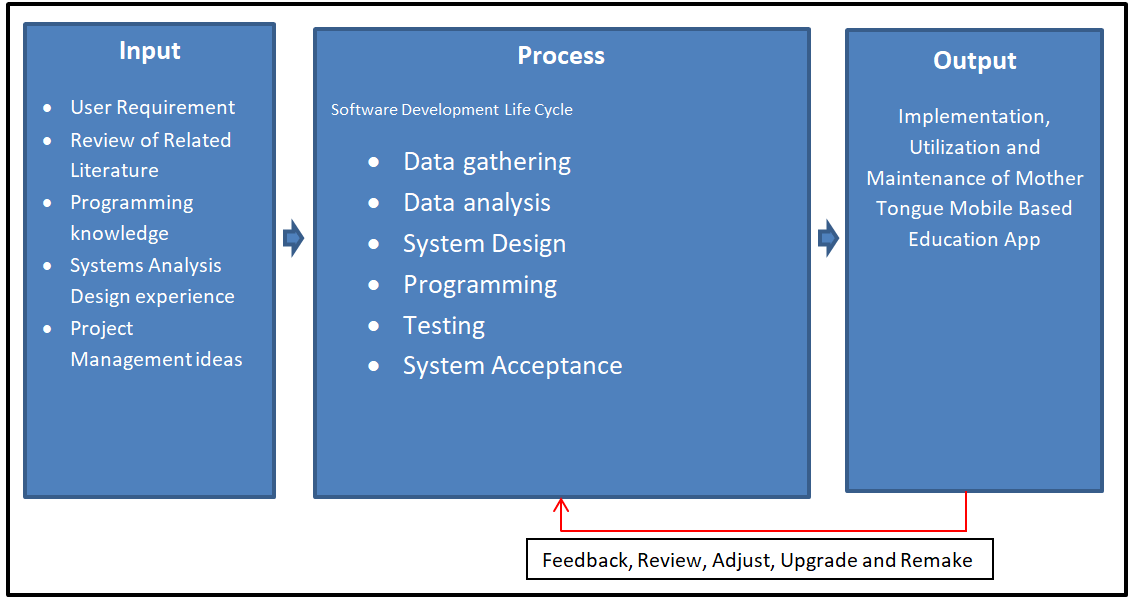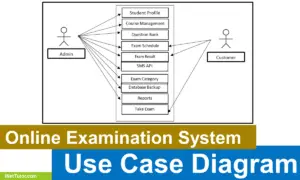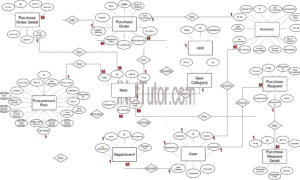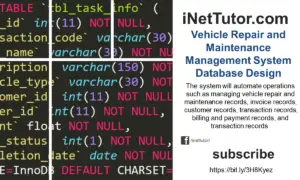Mother Tongue Education App Conceptual Framework
This tutorial will show you how to create a conceptual framework for your capstone project, Mother Tongue Mobile Based Education App. The input, process, output (IPO) model was used for the conceptual framework of this investigation.
About the Project
Table of Contents
Philippine educational institutions have already implemented mother tongue-based multilingual education in all public schools as part of the K-12 basic education program, specifically for kindergarten, grades 1, 2, and 3. The Philippines is the country with the most dialects, with 12 basic dialects utilized and spoken. Because of a lack of teaching materials, books are insufficient to learn everything, making the delivery of the mother tongue program the most challenging component. With the emergence of mobile applications, education has always been delicate in adapting the purpose of mobile applications and using it as a medium to deliver education to the learning. This project, entitled “Mother Tongue Mobile Based Education App,” addresses the program’s deficit aspect, which is a lack of resource materials to support learning. These projects will augment the program’s material resources.
Objective of the Study
- The projects’ goal is to create a new channel of learning that extends beyond the four walls of the classroom.
- Transform the manual system of instructing pupils into a technology-based learning system.
- To make it simple to find information on one’s mother tongue.
- The projects hope to make learning the mother tongue easier, more friendlier, and efficient by eliminating the need for paperwork and visual aids.
- To create an application that contains everything that students and teachers require.
- To inspire pupils to learn more and love local dialects by teaching from the heart.
- To reduce the teacher’s workload in terms of teaching and creating visual aids.
Conceptual Framework

The graphic above depicts the conceptual structure for the Mother Tongue Mobile Based Education App project. It is based on the IPO model, which is sometimes referred to as the input, process, and output model.
Input
This is where the researchers can now use their previous knowledge on systems analysis and design and project management.
Analysts collaborate with users to learn what they need from the system throughout the user requirement phase of system development. This phase includes user interviews, questionnaires, and other techniques of acquiring information. This information is used by analysts to build a requirements document that will be used to guide the rest of the system development process. This document should offer a list of the necessary features and functionalities for users to use the system. It should also include any special needs the users have for the system’s interface or presentation. Finally, it should describe how these features and functions will fit into the overall system architecture.
Process
This is the part where the researchers will select and choose the best software development life cycle model for the project.
Data gathering
During this phase, the researcher for this study acquired all potential needs for system development, including requirements gathered from the system’s end users. The researcher created a survey questionnaire that was validated by specialists. The questionnaires were intended to collect data in order to improve the performance of the proposed system for general community use in the future.
Data analysis
Consultation is used to acquire requirements from end users, and ideas are made. We also administered a survey questionnaire, which was approved by three specialists (IT Expert, English Grammarian, and Researcher). And these questionnaires served as our data collection instrument, measuring the performance of the manual system that served as the foundation for the construction of our suggested system.
System Design
During this phase, the prototype and planned system features are developed. A concrete grasp of how the system will work is also formed. In this section, we identify all of the necessary system inputs and outputs, as well as the design of data, processes, and interfaces.
Programming
In this stage, we materialized the whole idea of the software to be designed. We created the program for the proposed system. The actual coding of the software is based on the system design and the requirements needs to be met. This is where the proper execution of the previous stages ensures a smooth implementation.
Program testing
In this phase, the researcher performed series of testing to check for any possible problems may arise during implementation and operation of the software and if the specification has been met.
System acceptance
This is the final stage, where the system is being installed and to be maintained after actual implementation. One must take into consideration are the hardware and the software requirements for the proper installation of the system. As part of the acceptance of this phase, the client is required to have a user training to enable them to familiarize fully the whole system.
Output
After all of the necessary procedures have been completed, the project is brought to life and implemented in the real world. A new project is born, and it will be maintained in order for the project to be successful in the long run.
The process of putting the approved project plan into action is known as the systems and project implementation phase. This includes allocating resources, creating timelines, and ensuring that all stakeholders understand their roles and duties. It is crucial to remember that the implementation phase entails more than just carrying out the project plan; it also entails monitoring progress, making any adjustments, and ensuring that the project objectives are reached.
Summary
The conceptual structure of the Mother Tongue Mobile Based Education App is the topic of this research paper. The input, process, and output (IPO) model serves as the study’s conceptual framework. Defining user requirements, examining related literature, programming skills, systems analysis design experience, and project management principles are all part of the input phase. Once the input phase is completed, the researchers will proceed to the process step. The method used is the Software Development Life Cycle (SDLC) (SDLC). Data gathering, data analysis, system design, programming, testing, and system acceptance are all part of the SDLC technique. The output phase is the last stage before the produced system is implemented and used. The researchers will oversee the newly founded endeavor.
Message us on our Facebook page for the complete documentation of the project.
Readers are also interested in:
Mother Tongue Mobile Based Education App
Mother Tongue Mobile Application Review of Related Literature
Translator App for K-12 Mother Tongue Subject using JQuery Mobile and Phonegap Build
You may visit our Facebook page for more information, inquiries, and comments. Please subscribe also to our YouTube Channel to receive free capstone projects resources and computer programming tutorials.
Hire our team to do the project.


